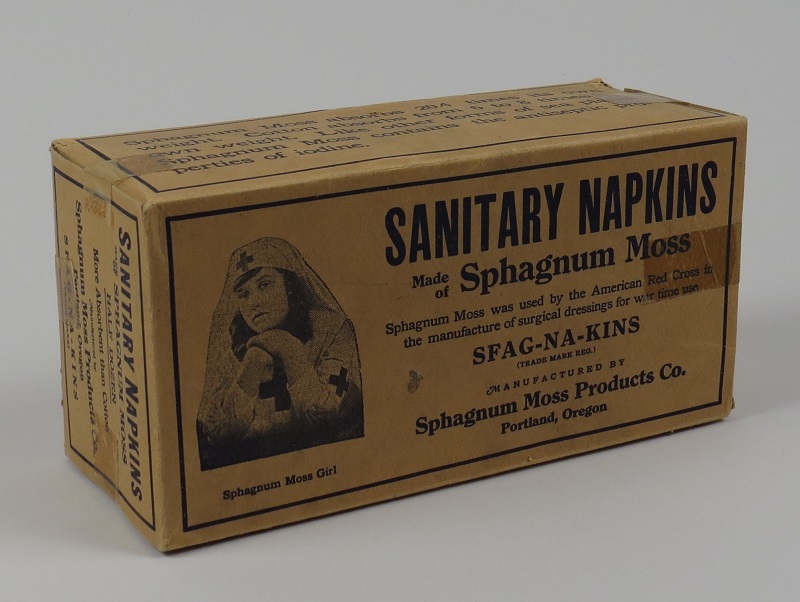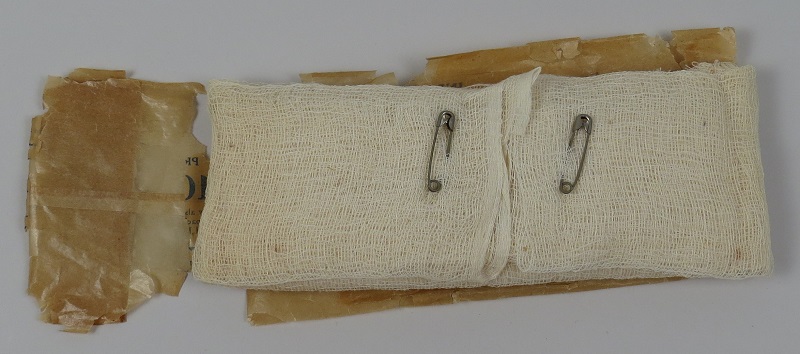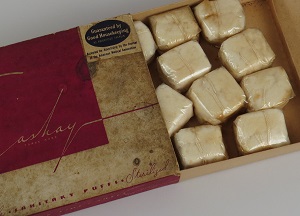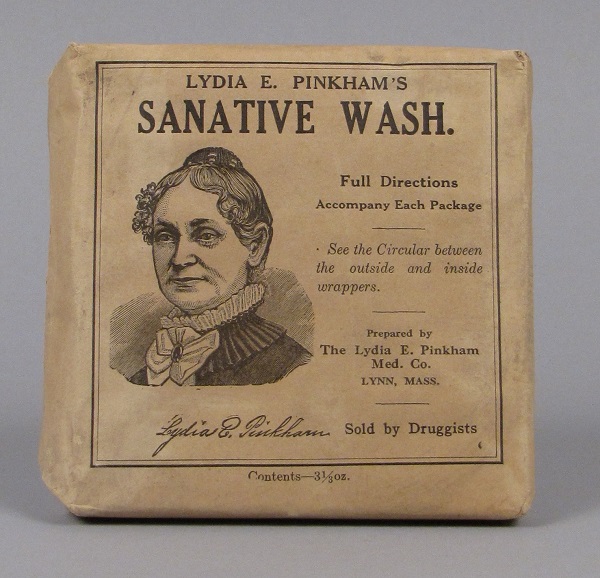This section includes products such as tampons and douches. The text below provides some historical context and shows how we can use these products to explore aspects of American history, for example, cultural discomfort with menstruation. To skip the text and go directly to the objects, CLICK HERE
The Museum’s collection of feminine hygiene products is small and lacks examples of many common and important products. Before the late 1970s, feminine hygiene was not understood to be a subject warranting serious cultural and historical research, and feminine hygiene products were not prioritized for collection or preservation. This attitude mirrored Americans’ discomfort with the idea of women’s hygiene. This discomfort is especially apparent in our continued reliance on the euphemism “feminine hygiene,” a term which we often use to discuss products associated with menstruation, genital cleanliness, and contraception. Use of this euphemism allows us to avoid any direct reference to female anatomy.
 |
| Lorate Douche Powder |
Feminine hygiene objects reflect this cultural discomfort. Sharra L. Vostral writes that these products assist “women in passing as healthy. They allow women to present themselves as non-menstruants.” Tampons, powders, douches and other similar products help us avoid personal or public awareness of a women’s menstruation. Advertisements for these products reassure women that no one will know that they are menstruating, that they are clean and inoffensive, and that they are free to live normally.
Despite our hesitance to focus on them, feminine hygiene products play a huge part in the daily health, well-being, and financial expenditures of American women. The global feminine hygiene industry is estimated to be worth $15 billion, and growing. Many women see these products not as a mere convenience, but as a necessity for performing their professional, social, and familial responsibilities. Yet, in the past few decades, concerns about the safety of feminine hygiene products, their effect on the environment, and the prohibitive cost or inaccessibility of the products for poorer women have emerged. These concerns have driven innovation within the feminine hygiene product market.
Before the advent of commercial feminine hygiene products, women used pieces of cloth to absorb menstrual fluids. They then washed and reused these cloths. Although Johnson & Johnson marketed a disposable sanitary napkin in 1896, it met with limited acceptance. However, surgical dressings developed during the First World War spurred innovation in commercial sanitary napkin designs, including products by Sfag-Na-Kins and Kotex.
Sfag-Na-Kins were developed from sphagnum moss, which can absorb more than 20 times its own dry weight in fluids and possesses antibacterial properties. The moss was grown in the Pacific Northwest, and Portland’s Sphagnum Moss Products Company processed the moss and wrapped it in a gauze covering. The packaging for Sfag-Na-Kins features a picture of an American Red Cross-capped “Sphagnum Moss Girl,” a reference to the product’s origin as a surgical dressing. Despite the product’s claims regarding its antibacterial action and greater absorbency than cotton, Sfag-Na-Kins do not appear to have been a success in the feminine hygiene market.
 |  |
| A box of Sfag-Na-Kins with the Sphagnum Moss Girl | A Sfag-Na-Kin |
Kotex napkins, however, met with great success. Introduced in 1921, Kotex used the same cellucotton (a wood pulp product with the texture of cotton) enclosed within a gauze sheath that it had developed for wartime bandages. A substantial advertising campaign in women’s magazines garnered strong sales through pharmacies and mail-order catalogs. The success of Kotex jumpstarted the feminine hygiene product market.
Tampons were used in medical practice before they were introduced for menstruation. They were used to stop bleeding in deep wounds as well as to introduce medicines, including those with contraceptive properties, into the vagina. Several patents for menstrual tampons were filed in the late 1920s and early 1930s. However, the design that is usually cited as the first successfully marketed tampon originated with the patent filed in 1931 by E.C. Haas. This design, with its paper-tube applicator, became the Tampax tampon.
 |  |  |
| Dr. Pierce's Medicated Tampons | Cashay Sanitary Puffs | Antiseptic Tampanades |
 |
| Lydia E. Pinkham's Sanitative Wash |
Environmental and safety concerns about tampons and sanitary napkins have led to the promotion of alternative products on the market. The plastic applicators and synthetic materials used in tampons and napkins contribute to American landfills. Some consumers have worried that the chemicals used to make tampons leach into their bodies, and the rare but serious risk of toxic shock syndrome is especially associated with high absorbency and synthetic-material tampons. Alternative feminine hygiene technologies include custom-made reusable fabric napkins, sea sponge tampons, silicon cups, and underwear containing special absorbent and antibacterial fibers.
Douches, suppositories, creams, and spray deodorants are also represented within the Museum’s collection. Older product packaging often masked the product’s intended effect, which sometimes included contraception, with vague language stating only that the product was “for feminine hygiene.” The collection also contains examples of products that we now associate mostly with household disinfectants or oral care, such as Lysol and Lavoris, which were also advertised as vaginal douches.
Bibliography ~ see the Bibliography Section for a full list of the references used in the making if this Object Group. However, the Feminine Hygiene Products section relied on the following references:
Freidenfelds, Lara. The Modern Period: Menstruation in Twentieth-century America. Baltimore: Johns Hopkins University Press, 2009.
Johnson, Emma. “Can These Panties Disrupt a 15 Billion Feminine Hygiene Market?” Forbes. Accessed May 6, 2016. https://www.forbes.com/sites/emmajohnson/2015/05/28/can-these-panties-disrupt-a-15-billion-feminine-hygiene-market/#6ed1444d6b78
Stalheim, T., S. Ballance, B. E. Christensen, and P. E. Granum. “Sphagnan – a Pectin-like Polymer Isolated from Sphagnum Moss Can Inhibit the Growth of Some Typical Food Spoilage and Food Poisoning Bacteria by Lowering the pH.” Journal of Applied Microbiology 106, no. 3 (March 1, 2009): 967–76. doi:10.1111/j.1365-2672.2008.04057.x.
Vostral, Sharra L. “Rely and Toxic Shock Syndrome: A Technological Health Crisis.” The Yale Journal of Biology and Medicine 84, no. 4 (December 2011): 447–59.
Vostral, Sharra L. Under Wraps: A History of Menstrual Hygiene Technology. Lanham: Lexington Books, 2008.







